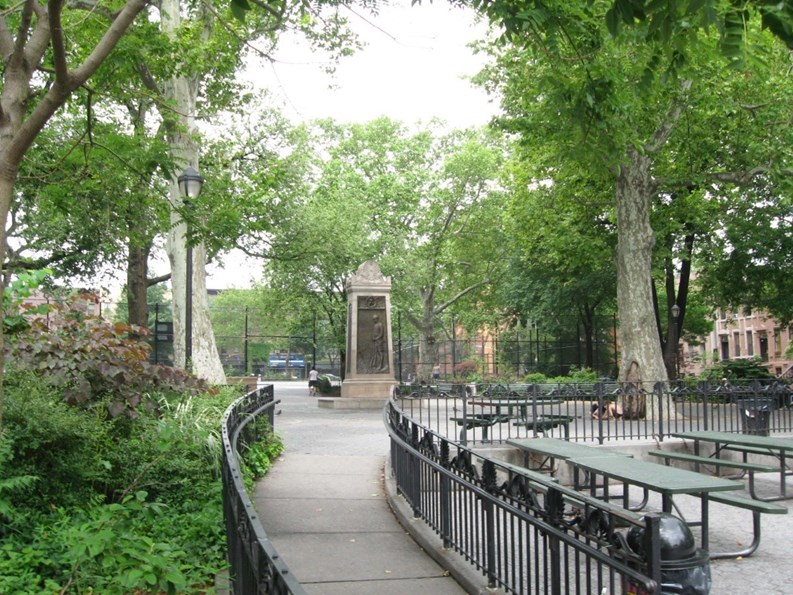It’s a pretty name for a pretty neighborhood. Located in the southern end of Brooklyn, Carroll Gardens has long been a destination for those in search of a little greenery to go with their city living. With its park, its tree-lined streets and the glorious gardens that fill the front yards of its brownstones, the neighborhood can be seen as an oasis of sorts. In recent years, it has grown in popularity and is a residential area of choice for families looking to settle down and commuters looking for a respite from the big city.
“Carroll Gardens is right at the heart of all the great things happening in Brooklyn,” says Craig Hammerman, district manager of Brooklyn Community Board 6, of which Carroll Gardens is a part. And increasingly, it’s becoming a destination in its own right.
Yesterday and Today
The area known today as Carroll Gardens once belonged to the Mohawk Indians whose tribal chief was Gowanus, after which the nearby Gowanus Canal was named. In 1636, the land was purchased by the Dutch West India Company. Two hundred years later, Carroll Gardens was settled by Irish immigrants who were later joined in the mid-19th century by Norwegians. Fifty years after that, Italian immigrants began arriving in the neighborhood. Today, although many younger residents have moved into Carroll Gardens from Manhattan or from other states, there is still a strong community of Italian-Americans living, working and raising families in the same buildings and on the same streets as their ancestors.
Originally named after Charles Carroll, a Revolutionary War veteran (and the only Roman Catholic signer of the Declaration of Independence), Carroll Gardens is perhaps best known for its brownstones with their signature front gardens. The gardens create front yards that are 33 feet, 5 ¼-inches deep—nearly unheard of in New York City. The gardens were created by surveyor Richard Butts in 1846. Today, the best examples of those homes can be found in the Carroll Gardens Historic District, which was designated in 1973 and includes President Street and Carroll Street bordered by Smith and Hoyt streets.
As its name suggests, Carroll Gardens is a neighborhood that loves its green spaces, providing a welcome refuge for those in search of a bit of nature to go with their city living. Carroll Park, Brooklyn’s third oldest park, has been a focal point for families since 1867. It is nearly two acres in size and was renovated in 1993.
Seeing the Sky
While Carroll Gardens always has been a desirable place to live for working and middle class families over the last two centuries, it has been gaining in popularity over the last few years and has truly come into its own as a destination neighborhood.
“The most dramatic changes have been in the last four or five years,” says Maria Pagano, who has lived in the area for 29 years and is president of the Carroll Gardens Neighborhood Association. “There’s been a tremendous influx of new residents.”
And it’s easy to see why: Carroll Gardens is two subway stops from Manhattan, allowing easy access for commuters. Residents can look outside their windows or walk down the street and see the Statue of Liberty each day. “There are tree-lined streets, it’s very family-based,” Pagano says. “You see your neighbors on the streets and it can take an hour to walk a couple of blocks because you keep running into people. It suits a lifestyle.” In short, she says, “Carroll Gardens really accommodates people who want to live in the city but still want to see the sky and know their neighbors. It’s an easy place to live.”
Hammerman agrees. The appeal of Carroll Gardens “is a combination of three things: location, people and the built form of the neighborhood. It’s a 10-minute train ride to Manhattan but that’s only if you really want to leave the neighborhood,” he says, laughing. “There’s so much to do here” that people really don’t need to make the trip.
“There’s a great mix of multi-generation families who still refer to Carroll Gardens as South Brooklyn, and arrivals of new folks who come to New York City with Brooklyn as their destination,” Hammerman says. The neighborhood has a wonderful stability, he says, that benefits from a vibrant community of young people as well as a commuter population. “It’s a great place for young families looking to settle down.”
And aesthetically, Carroll Gardens is hard to beat with its brownstones, gardens, and “deep, set-back houses that give a lot of light and air, bluestone sidewalks, tree-canopied streets,” Hammerman says. “You almost feel like you’ve been transported out of New York City into another time and place.”
Too Much, Too Fast
As the desirability of Carroll Gardens has grown in recent years, so has new development. And although Carroll Gardens residents welcome new neighbors and business owners, they are also increasingly alarmed at the size of the new developments and the impact they may have on the character and history of their neighborhood. In a neighborhood only 60 blocks or so in size and best known for its brownstones, tree-lined streets and low-rise buildings, the specter of 11-story residential buildings has been troubling. Especially if the influx of new residents is not met with an increase in new infrastructure to support so many new people. “This puts a tremendous burden on infrastructure in terms of transportation, schools, even sanitation,” Pagano says.
Because Carroll Gardens is not a protected historic neighborhood, zoning laws permit larger buildings to be erected in place of existing buildings. One multi-story building, for example, is being built in the footsteps of what were once two brownstones. “And now there’s 11 stories of neighbors looking down at you,” Pagano says, “and suddenly people are horrified.”
“This trend has alarmed a lot of people,” Hammerman says. “Not everyone looking to build in the community shares the same goals as the residents.”
While some residents may still want to sell to developers or are ambivalent about the growth, many others do not and it’s these residents who have begun mobilizing with great effectiveness, organization, enthusiasm and persistence.
“This is what works for the greater majority,” Pagano says. “We are not quitting until we have some sort of zoning protection.” Hammerman says he is beginning to see the results of these community efforts. “They’ve been organizing and have caught the attention of local elected officials and various government agencies,” he says. “The community push is gaining momentum and people in government are understanding.”
The rapid growth has influenced the character of the neighborhood in other ways, too, with retail shops and restaurants being affected. Many of the small shops, the Mom-and-Pop bakeries and butchers, are being squeezed out as landlords are raising rents to attract more high-end retailers. “There’s less and less of the individual shopping stores that were once a hallmark of the residential areas,” Hammerman says. “Individual food specialists have given way to a trend of restaurants, which is reflecting a trend away from in-home food preparation to more eating out.” This may be a reflection of the young families moving into the area as well as the change in retailers. “Some in the community have been hurt by those losses. The increased rents also have shifted the economy away from the ‘Mom and Pop’ stores,” Hammerman adds.
Pagano agrees, noting that in some areas rents have quadrupled for restaurant spaces. “Landlords are establishing high rents and businesses are staying a very short time because they can’t survive on walk-in traffic,” she says. “It’s hard for someone to open a dress shop when the CVS can pay $38,000 a month in rent for the same space.”
All of this is not to say that the residents of Carroll Gardens don’t want change or growth, Pagano says. It is simply about finding the right balance and protecting the character of the neighborhood. Residents know it can happen as dozens of neighborhoods throughout Manhattan have already received zoning protection from the city and are flourishing.
Calling Carroll Gardens ‘Home’
The good news is that for those who want to make Carroll Gardens their home, the expansion of residential building is offering more options. “A lot of brand-new condos have come on the market since spring 2008,” says Toni D’Andrea of the real estate firm D’Andrea Craig Realty based in Carroll Gardens. “And there are still more being built.”
Unlike many other areas of the country and within New York City itself, sales in Carroll Gardens have remained steady, D’Andrea says. “It’s still active. Buyers are still buying; they’re just taking a little longer. Buyers are being more cautious about financing, as are the banks. But it’s moving along at a nice pace.”
While prices in Carroll Gardens were on the rise in recent years, they have remained steady for the last 12 months or so. A two-bedroom condo these days “will cost anywhere from $800,000 or $900,000 to more than $1 million, depending on the amenities,” D’Andrea says.
Things are changing in terms of buyers in a way that shows the strength of Brooklyn and Carroll Gardens as destinations in and of themselves compared to Manhattan. “Most of our buyers used to come from Manhattan and were looking at Brooklyn to find a bargain, but now it’s people who already live here—renters—who want to stay and settle in the neighborhood,” says D’Andrea, who is a lifelong resident of Carroll Gardens herself.
What does the real estate future look like for this neighborhood? “I do not see this neighborhood going down,” D’Andrea says. “Carroll Gardens will always be just ten minutes from Manhattan and there will always be people who want to own homes here, so I think the future looks bright.”
As this vibrant neighborhood grows and evolves, there is little doubt that Carroll Gardens will maintain the charm and beauty that has made it such a popular place to live and raise a family.
Liz Lent is a freelance writer and a frequent contributor to The Cooperator.







Comments
Leave a Comment